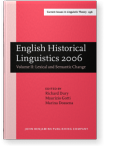The diachronic development of the intensifier bloody: A case study in historical pragmatics
This paper traces the history of bloody from a holistic perspective, that is, by considering bloody in relation to other items within the system of intensification. Using corpus evidence, the paper rejects current etymological proposals and suggests that the Reformation was the possible socio-historical context wherebloody became a taboo word and an intensifier. It goes on to explain how the adjective bloody became an intensifying adverb in collocation with ‘drunk’ through the cognitive-pragmatic processes of selective binding and analogy. This grammaticalisation cline sets bloody apart from a number of other intensifiers such as very, extremely, utterly, absolutely, which, unlike bloody, were originally manner adverbs and have severely reduced their syntagmatic variability. It also sets it apart from intensifiers such as good, nice, dirty, jolly, pretty and lovely, which, unlikebloody, always retain their descriptive meaning when used as adjectives.
Cited by (2)
Cited by two other publications
Palacios Martínez, Ignacio M. & Paloma Núñez Pertejo
This list is based on CrossRef data as of 11 july 2024. Please note that it may not be complete. Sources presented here have been supplied by the respective publishers.
Any errors therein should be reported to them.
